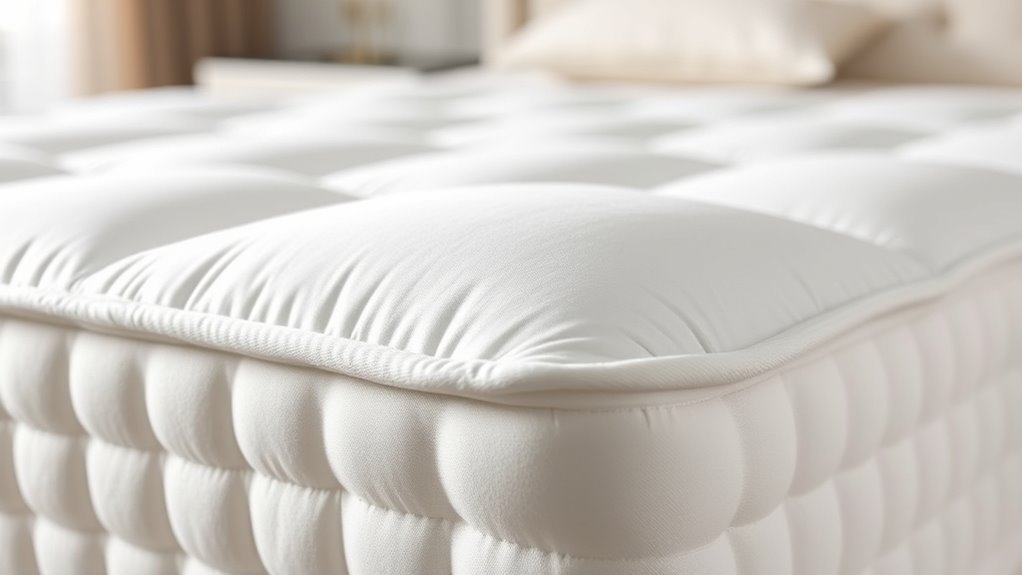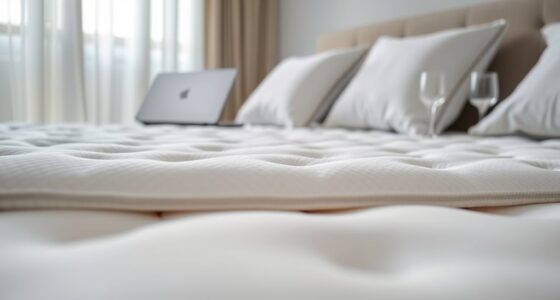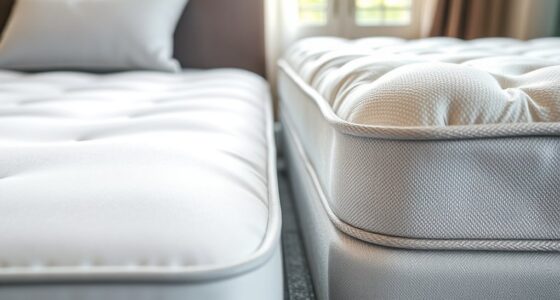A pillow top mattress features an extra plush layer sewn onto the top, giving you a soft, cushioned surface for better comfort and a cozy sleep experience. It’s great if you prefer a softer feel, want better pressure relief, and enjoy luxury bedding. However, it might not be ideal if you need firm support or worry about durability. Want to discover whether a pillow top is the right choice? Keep exploring for more details.
Key Takeaways
- A pillow top mattress has an extra cushioning layer sewn onto the top for a plush, soft sleeping surface.
- It enhances comfort and pressure relief, making it ideal for side sleepers or those seeking a softer feel.
- The plush layer can be made of memory foam, gel-infused padding, or latex, impacting support and temperature regulation.
- Pillow top mattresses require regular maintenance and may soften over time, potentially affecting durability and support.
- They are generally more expensive, and their comfort benefits should be weighed against potential wear and personal support needs.
Defining a Pillow Top Mattress
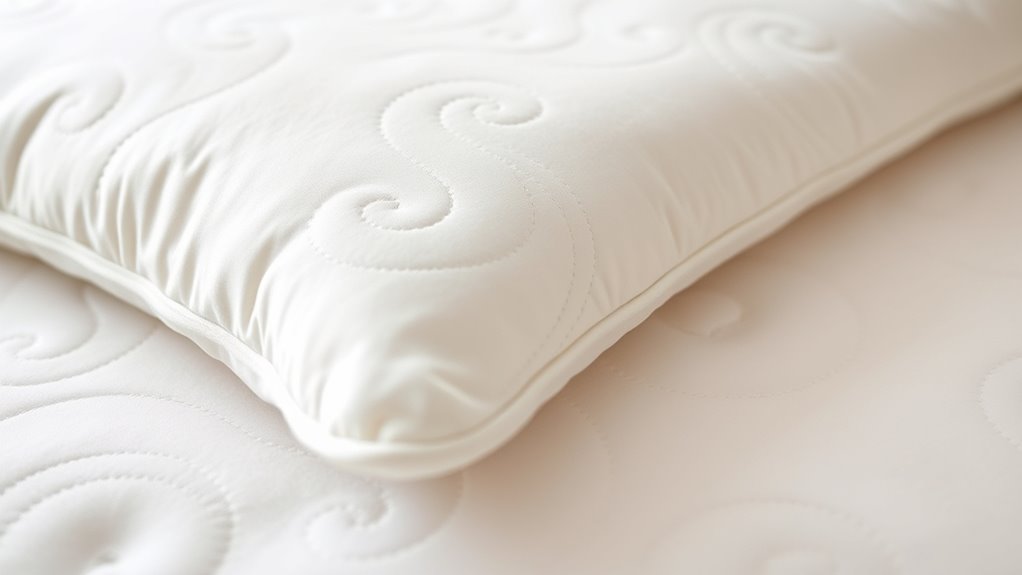
A pillow top mattress is a type of mattress that features an extra layer of padding sewn directly onto the top surface, creating a plush, cushioned feel. This design enhances your sleep environment by offering immediate comfort and support. The added pillow top transforms your bed into a cozy retreat, making it easier to unwind at night. To maximize comfort, consider pairing your mattress with suitable bedding accessories like soft sheets, plush pillows, and a warm comforter. These accessories complement the plush surface, creating a more inviting sleep space. Pillow top mattresses are ideal if you value a luxurious, cushioned feel every time you lie down, helping you relax and enjoy restful sleep. Their design seamlessly integrates with your bedding setup, elevating your overall sleep experience. Additionally, understanding sleep surface types can help you choose the best mattress for your needs.
Materials Used in Pillow Top Layers

The materials in pillow top layers can markedly impact your comfort and support. You might find memory foam, gel-infused padding, or latex and fiber fills offering different feels and benefits. Understanding these options helps you choose the best pillow top for your sleep needs. Additionally, the diverse roles played by various materials can influence the longevity and breathability of your mattress.
Memory Foam Layers
Memory foam layers in pillow top mattresses are known for their ability to contour to your body, providing personalized support and pressure relief. These layers adapt to your unique shape, making them ideal for various sleep positions. Whether you sleep on your side, back, or stomach, memory foam helps reduce pressure points and promotes proper spinal alignment. Additionally, high-quality memory foam often incorporates color accuracy to enhance overall comfort and visual clarity. They absorb movement, minimizing disturbances if you share a bed. Some memory foam is infused with cooling agents to prevent heat buildup. The density of the foam affects firmness, so choose according to your preferred sleep style.
Gel-Infused Padding
Gel-infused padding has become a popular material in pillow top mattresses because it actively helps regulate temperature and keeps you cool throughout the night. This feature benefits your sleep posture by preventing overheating and discomfort that can lead to tossing and turning. If you tend to sleep hot or live in a warm climate, gel-infused layers can make a noticeable difference in your overall sleep quality. Additionally, gel padding often contains hypoallergenic properties, making it suitable for allergy concerns. It resists dust mites and mold, reducing potential triggers for allergy sufferers. As a result, you enjoy a cleaner, healthier sleep environment. Overall, gel-infused padding offers a cooling, hypoallergenic option that enhances comfort and supports better sleep posture.
Latex or Fiber Fill
Materials like latex and fiber fill are popular choices for pillow top layers because they offer a combination of support and softness. Latex filling provides a responsive, durable feel that contours to your body, making it ideal for those seeking pressure relief. Fiber fill, on the other hand, adds a plush, cushioning layer that enhances comfort without sacrificing breathability. Additionally, both materials can benefit from AI-driven customer feedback analysis, helping manufacturers improve product quality based on consumer preferences. Both materials can help regulate temperature, keeping you comfortable throughout the night.
Choosing between latex and fiber fill depends on your preferences for support, softness, and breathability. Both options can enhance your pillow top mattress, making it feel more luxurious and tailored to your needs.
How Pillow Top Mattresses Differ From Traditional Beds
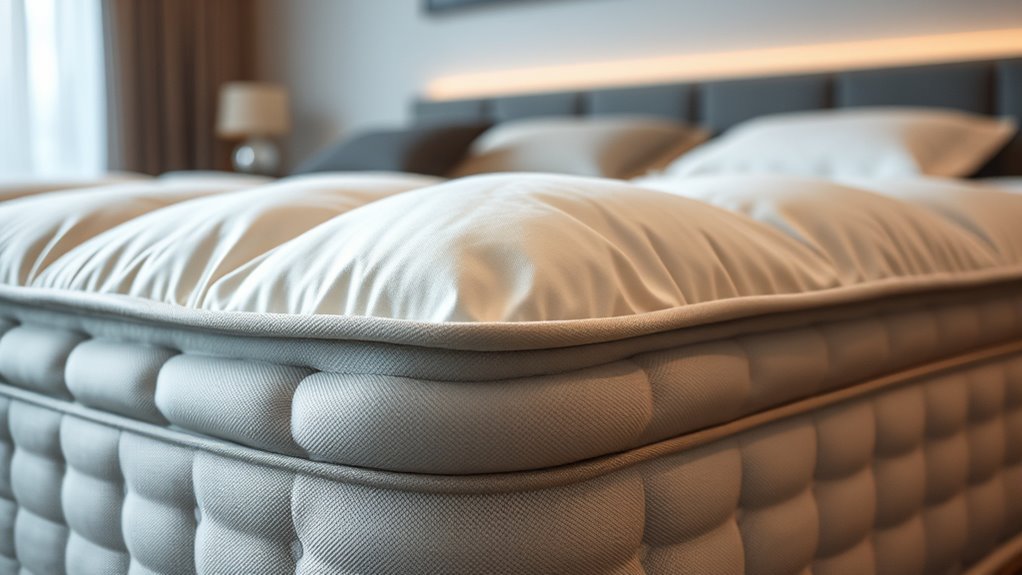
Pillow top mattresses stand out from traditional beds primarily because of their plush, extra layer of cushioning sewn directly onto the surface. This added comfort impacts sleep ergonomics by providing a softer, more contouring surface that supports your body’s curves. Unlike standard mattresses, which rely solely on the core materials, pillow tops offer enhanced pressure relief and a more luxurious feel. Additionally, pillow top models often come with specific mattress certifications that assure quality, safety, and durability, giving you peace of mind. While traditional beds may prioritize firmness and support, pillow tops focus on plushness and comfort, making them suitable for those who prefer a softer sleeping surface. These differences highlight the unique appeal of pillow top mattresses in your sleep setup. Moreover, the additional cushioning layer can contribute to a more inviting and restful sleep environment, enhancing overall comfort.
Benefits of Choosing a Pillow Top Mattress
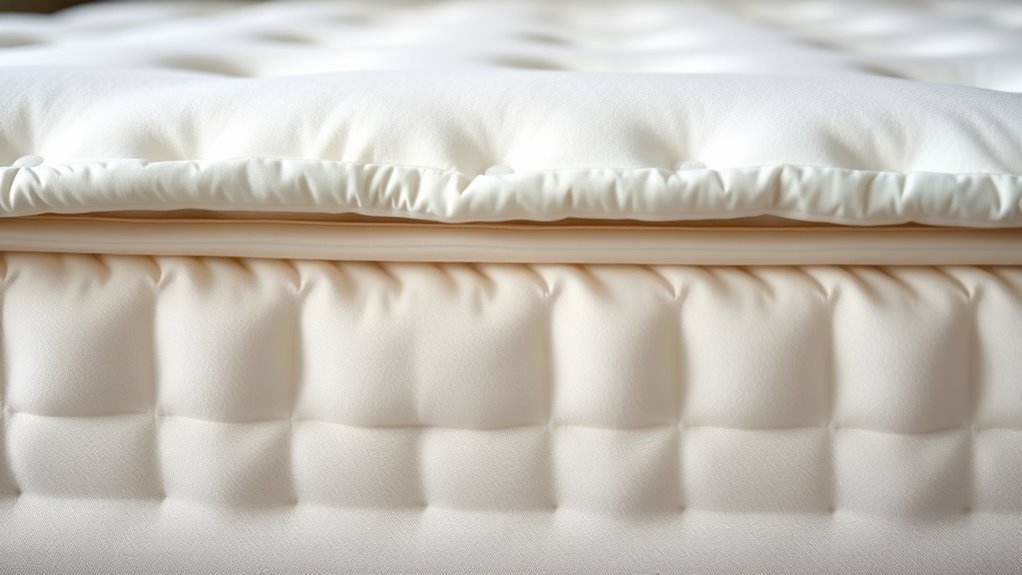
Choosing a pillow top mattress can considerably enhance your sleeping experience because it offers unmatched comfort and support. This can help improve your sleep patterns by reducing tossing and turning, so you wake up feeling refreshed. Additionally, many pillow top mattresses are designed with hypoallergenic materials, which can address allergy concerns and keep dust mites or allergens at bay. The plush surface provides better pressure relief, easing aches and pains, especially in your shoulders and hips. Plus, the extra cushioning can minimize movement transfer, so your partner’s movements don’t disturb your sleep. Overall, a pillow top mattress promotes restful nights, supports your body properly, and can contribute to healthier sleep habits, making it a worthwhile investment for comfort and well-being. The plush surface can also appeal to those seeking a luxurious sleeping experience.
Potential Drawbacks and Considerations
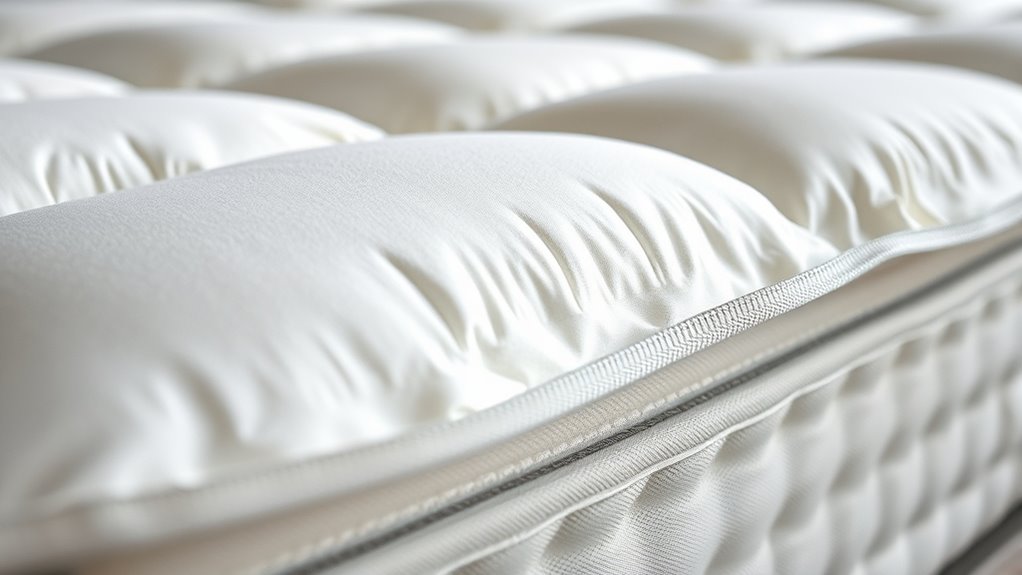
While pillow top mattresses offer many benefits, they also come with potential drawbacks that you should consider. One issue is limited firmness options, which may make it harder to find a mattress that perfectly matches your preferred level of support. Some pillow tops tend to soften over time, losing their initial plushness and potentially causing discomfort. Additionally, if you have allergy concerns, be aware that pillow tops can trap dust, allergens, and pet dander, making regular cleaning essential. Not all pillow tops are easily washable, which could worsen allergy symptoms if not maintained properly. In the end, pillow tops often cost more than standard mattresses, and their plush layers may wear out faster, leading to eventual sagging and the need for replacement sooner than expected. Furthermore, understanding the materials used in tableware can help ensure you select products that are durable and suitable for your needs.
Suitable Sleepers for Pillow Top Designs
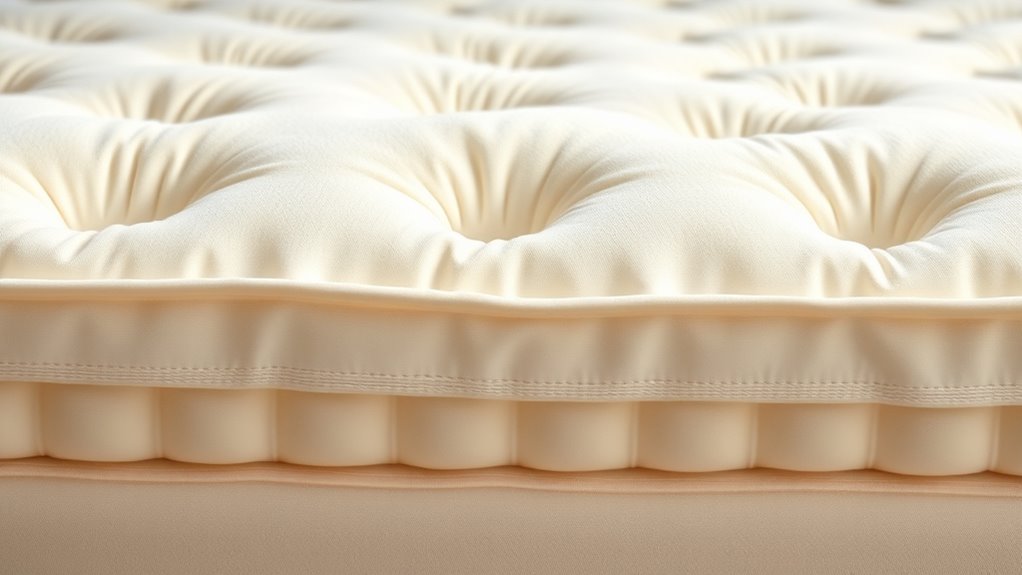
Because of their plush surface and cushioning layers, pillow top mattresses are especially suitable for side sleepers who benefit from extra pressure relief and contouring. They help align your spine and reduce discomfort in hips and shoulders, promoting better sleep hygiene. If you prioritize a softer, more luxurious feel, a pillow top can enhance your sleep experience. To maximize comfort, consider bedding accessories like memory foam pillows or mattress toppers that complement the plush surface. Keep in mind, these mattresses may retain heat, so breathable sheets are a good addition. Pillow tops are best for those seeking a gentle, contouring sleep surface. They’re ideal for side sleepers, those with joint sensitivities, or anyone who prefers a softer, more cushioned feel. Incorporating natural elements like organic bedding materials can further enhance your sleep environment and promote relaxation.
Maintaining and Caring for a Pillow Top Mattress
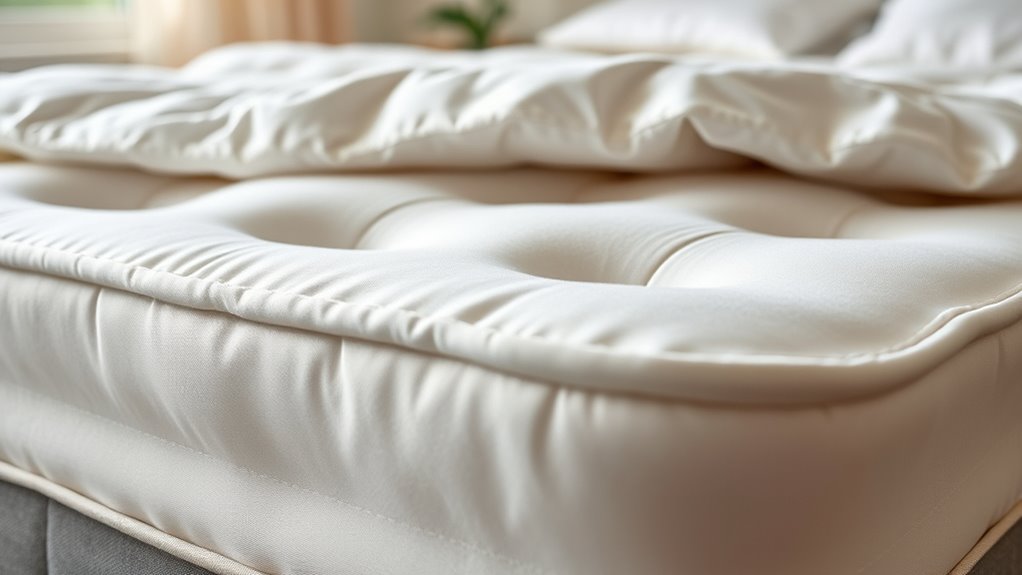
To keep your pillow top mattress plush and supportive, regular maintenance is essential. Proper care enhances sleep hygiene and prolongs its lifespan. Rotate your mattress every 3-6 months to prevent indentations and uneven wear. Use a mattress protector to guard against spills and dust mites. Keep the surface clean by vacuuming weekly and spot-cleaning stains promptly. Be aware of your mattress warranty; improper care may void it. Additionally, maintaining good sleep hygiene practices can improve your overall rest quality. Here’s a quick guide:
| Action | Frequency | Benefit |
|---|---|---|
| Rotate mattress | Every 3-6 months | Prevents uneven wear |
| Use a mattress protector | Always when in use | Maintains cleanliness, protects warranty |
| Vacuum surface | Weekly | Reduces dust and allergens |
| Spot-clean stains | As needed | Keeps surface fresh |
| Air out mattress | Occasionally, for a few hours | Improves sleep hygiene |
Comparing Pillow Top Mattresses to Other Plush Options
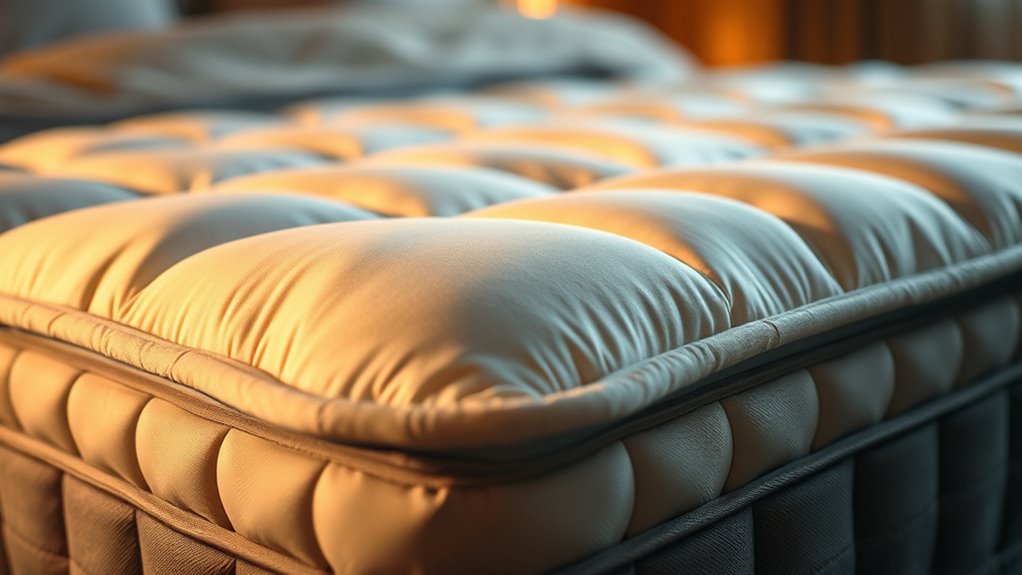
Pillow top mattresses are popular for their plush comfort, but they aren’t the only option if you seek a soft, luxurious sleep surface. When comparing them to other plush options like memory foam or hybrid mattresses, consider your sleep posture and mattress portability. Pillow tops often offer better support for side sleepers, but memory foam molds closely to your body, enhancing pressure relief. Hybrids combine innerspring support with a plush top layer, balancing comfort and stability. Additionally, pillow top mattresses tend to be heavier and less portable, making them harder to move or adjust. If easy transport or frequent repositioning matters to you, alternatives like thinner memory foam layers could be better. Weight and portability are important factors to consider when choosing a mattress, especially if you plan to move or frequently change your sleeping setup. Ultimately, your choice depends on how you prioritize comfort, support, and convenience.
Cost Factors and Value for Money
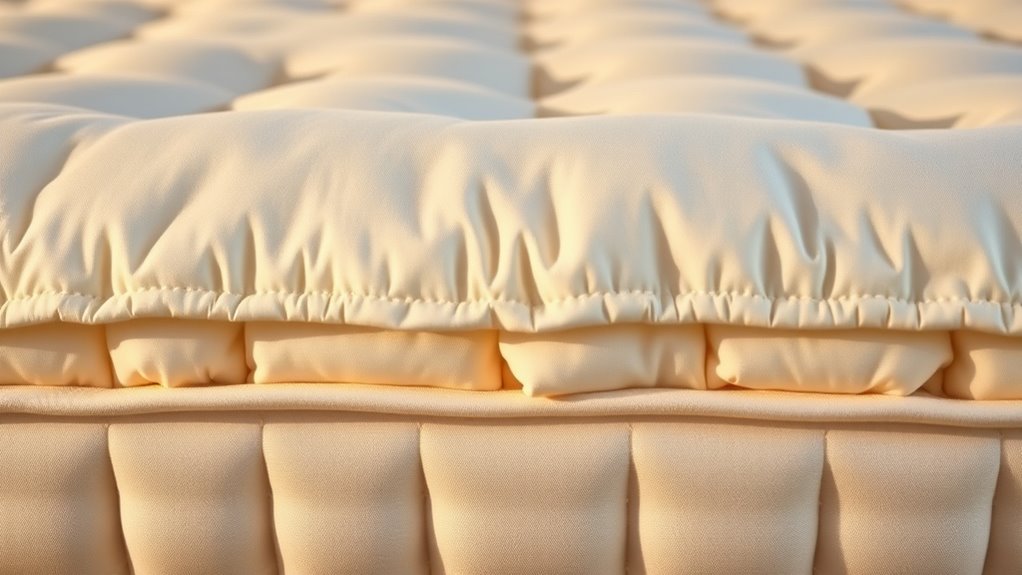
While plush comfort is appealing, understanding the cost factors of pillow top mattresses helps you determine their true value. Generally, these mattresses range from mid to high price points, influenced by materials like memory foam, latex, or innerspring cores. Higher-quality options tend to offer better durability, enhancing your sleep hygiene by reducing discomfort and night-time disturbances. Your bedroom decor also plays a role; a stylish, well-designed space can justify investing in a premium pillow top mattress that complements your aesthetic. Keep in mind that price isn’t the only indicator of value—durability, comfort, and support contribute notably. Spending more upfront on a quality pillow top can translate into longer-lasting comfort and better sleep, making it a worthwhile investment for your overall well-being. Glycolic acid products are known for improving skin texture and radiance, similar to how a good mattress can enhance your sleep quality.
Making an Informed Decision: Is It Right for You?
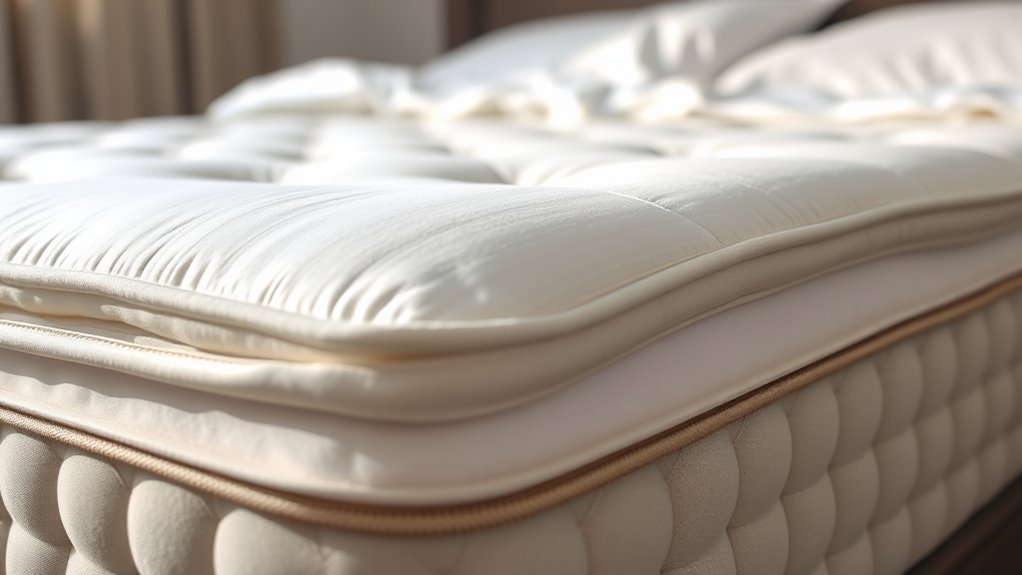
To decide if a pillow top mattress is right for you, consider your comfort preferences and whether extra cushioning feels best. Think about your budget and if the added support offers good value over time. Also, evaluate its durability and how well it maintains support to make certain it meets your long-term needs.
Comfort Preferences Matter
Your comfort preferences play a critical role in choosing the right mattress, especially when considering a pillow top model. If you prioritize staying cool during the night, a pillow top with breathable materials can help with temperature regulation. Your sleep position also matters; side sleepers may prefer a softer surface, while back or stomach sleepers might need more support.
Consider these factors:
- Sleep position influences how much cushioning you need for pressure relief.
- Temperature regulation is essential if you tend to overheat or sweat at night.
- Comfort level depends on whether you like a plush, medium, or firm feel.
Knowing your personal preferences ensures you select a pillow top that enhances your sleep quality and keeps you comfortable all night.
Budget and Value Considerations
Considering your budget is essential when choosing a pillow top mattress, as prices can vary widely based on materials, brand, and features. While a higher price often correlates with better sleep quality and mattress durability, it’s important to find a balance that suits your needs. Think about how much you’re willing to invest for comfort and longevity. Here’s a quick overview:
| Budget Range | Key Features | Sleep Quality & Durability |
|---|---|---|
| Budget | Basic materials, thinner layers | May compromise on durability |
| Mid-Range | Better materials, moderate comfort | Improved sleep quality |
| Premium | High-quality materials, plush feel | Long-lasting, durable mattress |
| Luxury | Top-tier materials, advanced features | Superior sleep experience |
| Value | Good balance of cost and performance | Reliable sleep and durability |
Additionally, researching mattress materials can help you identify options that meet your comfort and durability needs within your budget.
Longevity and Support
Choosing the right pillow top mattress involves more than just initial comfort; it also means thinking about how long it will last and how well it supports your body over time. A durable mattress maintains its shape and support, which is essential for good sleep hygiene and proper spinal alignment. When evaluating longevity, consider factors like the quality of materials and construction. Supportiveness is key for preventing aches and maintaining healthy posture. Look for:
- High-density foam or innerspring cores that resist sagging
- Reinforced edges for consistent support across the mattress
- Proper maintenance to extend lifespan and preserve bedroom decor
A supportive pillow top can improve sleep quality now and for years, making it a worthwhile investment if longevity and support are priorities. Additionally, understanding mattress construction can help you make more informed decisions about durability and comfort.
Frequently Asked Questions
How Long Does a Pillow Top Mattress Typically Last?
A pillow top mattress usually lasts about 7 to 10 years, but durability concerns can vary based on usage and maintenance. To extend its lifespan, you should rotate it regularly and use a mattress protector. Proper maintenance helps prevent sagging and keeps the plush top in good shape. Keep an eye on signs of wear, and replace it when comfort and support diminish, ensuring you get the most out of your investment.
Can Pillow Top Mattresses Be Used With Adjustable Beds?
You might think pillow top mattresses can’t handle adjustable beds, but that’s not true! In fact, many pillow top firmness levels are compatible with adjustable bases, transforming your sleep experience into a luxurious paradise. Just make certain your mattress is flexible enough—most modern pillow tops are designed for this. Double-check the mattress compatibility before buying, and you’ll enjoy perfect support and plush comfort, no matter how you like to adjust your sleep position.
Are Pillow Top Mattresses Suitable for Allergy Sufferers?
If you’re an allergy sufferer, a pillow top mattress can be suitable if you choose hypoallergenic options. These mattresses help reduce allergy triggers like dust mites and pet dander. Look for models with allergen-resistant covers and materials that discourage dust accumulation. Regular cleaning and using allergen-proof bedding further improve your sleep environment. So, yes, pillow top mattresses can be allergy-friendly when paired with hypoallergenic features and proper maintenance.
What Are the Best Cleaning Methods for Pillow Top Layers?
Think of your pillow top layer as a delicate cloud needing gentle care. To keep it fluffy, regularly vacuum and spot clean with mild detergent for pillow care. For stain removal, act quickly with a soft cloth and a mix of water and gentle soap. Avoid harsh chemicals and excessive moisture, which can damage the padding. Proper cleaning maintains comfort and prolongs the life of your pillow top mattress.
How Do Pillow Top Mattresses Perform in Terms of Heat Retention?
You might notice that pillow top mattresses can trap heat, affecting your sleep. Their breathability comparison shows they often retain more heat than firmer mattresses. However, many models now incorporate cooling technologies like gel-infused memory foam or breathable covers to improve airflow. If heat retention is a concern, look for mattresses with these features, as they help regulate temperature and keep you comfortable throughout the night.
Conclusion
If you prioritize comfort, a pillow top mattress could be a game-changer, with over 60% of sleepers reporting better sleep quality. Its plush surface offers added cushioning and support, making it worth considering if you value a luxurious feel. Just weigh the potential costs and maintenance needs. Ultimately, choosing a pillow top depends on your sleep preferences and budget—so make an informed decision to enjoy restful nights ahead.
